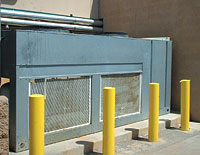The Environmental Protection Agency (EPA) is one of the reasons why Mission Foods decided to voluntarily convert its facilities to non-ozone-depleting refrigerants. EPA's Bakery Partnership Agreement, which was instituted in 2002, allows baking companies to voluntarily audit their facilities for compliance with the Clean Air Act's National Recycling and Emission Reduction Program in exchange for reduced penalties.
The refrigerant recycling and emissions reduction regulation requires all bakery industrial process appliances containing 50 pounds or more of ozone-depleting refrigerants to maintain records of leaks and proof that the leak was repaired within the time limits specified in the regulation. Leaking appliances that cannot be fixed must be replaced or shut down.
In the Phoenix area, Mission Foods operates a plant that contains two Century air-cooled chiller systems, as well as a warehouse with two Russell walk-in units. The four systems utilized eight compressors and contained far more than 50 pounds of R-22, so Tom Kuffler, president, Air Refrigeration LLC, Tempe, Ariz., had his hands full when he tackled this conversion.
Tuning Up
Kuffler was familiar with Mission Foods, because in 2003 his team had changed out all the interior fancoil and air-handling units in the tortilla maker's walk-in coolers. The existing coils were copper with aluminum fins, and the humidity and heat coming off the tortillas was causing electrolysis. Kuffler replaced these with copper coils with copper fins to eliminate the problem.While performing this work, the plant manager mentioned that the company was joining EPA's Bakery Partnership Agreement and converting all systems containing more than 50 pounds of R-22 to a non-ozone-depleting refrigerant. In January 2004, Kuffler was asked to figure out the best way to convert the systems in the Phoenix plant and warehouse.
The chillers and walk-in units were less than five years old, so replacing the equipment was out of the question. Converting to a different refrigerant made sense, but there was some debate as to which refrigerant to use. Mission Foods originally suggested R-134a, but once Kuffler started his research he found that R-404A or R-507 would probably work best in this situation.
"We ultimately settled on R-404A, because it was closest to R-22 in performance in this particular application," said Kuffler. "We researched this issue extensively and also utilized a third-party confirmation. We also worked with Copeland, which manufactured six of the compressors, and they said we could use either refrigerant."
Before starting the conversion, Kuffler made sure that the chillers and walk-in units were operating at their maximum efficiencies. He installed unloaders on the equipment and basically tuned everything up, so that the baseline readings would be accurate.
Baseline readings are crucial to ensure the systems are operating optimally after the conversion. These readings should include temperature and pressure measurements throughout the system, including the evaporator, compressor suction and discharge, condenser, and expansion device.

Starting The Process
Once the tune-up was finished, Kuffler recovered the existing R-22 charge and recorded the amount he extracted. After that he needed to decide which compressor lubricant to use. Mineral oil or alkylbenzenes are typically used as lubricants, but to achieve miscibility of the new refrigerant with the lubricant, a polyolester oil (POE) must be used."We needed to get the old mineral oil content down below 5 percent of the total, and it took several tries to do it," noted Kuffler. "In this application there are very long line sets, and some of the oil can migrate through the system. We had to be careful measuring the oil and be very cognizant of how much was coming out."
After recharging the compressors with the first load of POE oil, the systems were recharged with the existing R-22 and then run for 24 to 48 hours. The process was repeated - sometimes several times - to make sure that a level of 95 percent POE oil was obtained. Once the POE oil was at an acceptable level, Kuffler checked the expansion devices, replaced the filter-driers, reconnected the system, evacuated the old charge, and then recharged with the new R-404A. The four systems were charged with a total of 1,800 pounds of R-404A.

"This is where the tricky part comes in," said Kuffler. "You spend a lot of time adjusting your TX valves and your charges, trying to get back to the baseline readings - that's why the initial baseline readings are so important. Then you check for leaks. With R-22 maybe there were no leaks, but you pop in R-404A, which operates at a higher pressure, and suddenly you can have little pinhole leaks."
Leaks are a bigger deal with R-404A, because the refrigerant will fractionate and leak off the lighter blends first. If the leak is not detected and fixed in a timely manner, the entire charge may need to be replaced, which becomes very expensive.

Some Challenges
Leakage was a problem in the converted systems, but it wasn't due to pinholes. After the conversion was finished and everything seemed to be running fine, the plant and warehouse started to experience significant leakage on all the systems."We were stumped as to what was going on," noted Kuffler. "Then we realized that the POE oil, which is hygroscopic in nature, started to dehydrate all the head gaskets, so we had to replace all the head gaskets on the eight compressors. That was definitely unexpected."
The higher operating pressures of R-404A caused two other problems as well. The first was a serious stress fracture on one of the coils at the warehouse location. Once the coil was replaced, that problem was solved.
The second involved installing high-pressure relief valves on the six compressors at the plant, because the operating pressure of R-404A exceeded the pressure and volume ratings of the existing valves.
Probably the biggest challenge was time. The plant and warehouse run constantly, with the exception of one day a week when everything closes down for scheduled maintenance. Kuffler and his team had one day a week to work on the conversion, so it took three months to finish it.
"Overall, though, I think things went very smoothly," said Kuffler. "I think we did a really good job for them, and they are very pleased. The people at Mission Foods were great to work with – they were willing to commit the resources and the funds to do the conversion properly, and that's really the way they run their whole organization."
Publication date: 02/07/2005


Report Abusive Comment